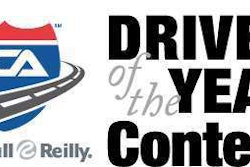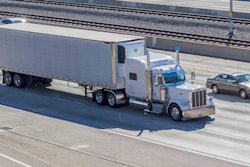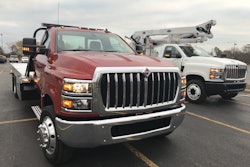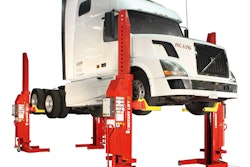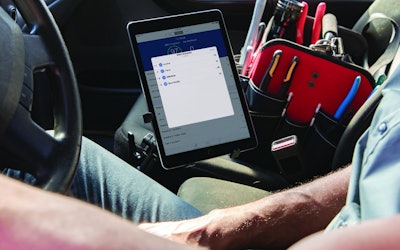 The Coach app from Verizon Connect Coach app lets drivers track their progress towards individual safety goals and notes areas in need of improvement.
The Coach app from Verizon Connect Coach app lets drivers track their progress towards individual safety goals and notes areas in need of improvement.Do your drivers have an opportunity to elevate their status at your workplace by using a system that tracks their performance with metrics they directly control?
If not, it is fairly easy to create a driver scorecard with the amount of performance and safety data that is available. By making scorecard information easily accessible to drivers, many will work on improving their skills voluntarily.
Driver scorecards are common features in mobile fleet management systems, and fleets can also bring together data from multiple sources to create their own custom versions. Increasingly, the trend is to use technology that gives drivers instant feedback and coaching rather than reporting on past performance.
Coaching apps
Driver coaching apps, common among fleet mobility platforms, are widely used to give drivers feedback on their daily performance.
Verizon Connect offers an option for its Fleet platform, the Coach app, that drivers use to track their progress towards individual safety goals and note areas in need of improvement. Fleet managers see the driver scorecard data on a higher level to identify areas of focus through the web-based Fleet portal or with a mobile app called Spotlight, says Kevin Aries, head of global product success.
A leaderboard feature in Coach will show drivers where they rank among their peers for different safety metrics. Verizon Connect also has various driver productivity metrics that can be added to separate driver scorecards from its suite of routing and fleet management applications, he says.
Coaching apps are evolving to become real-time feedback mechanisms that interact with drivers during their workday.
“We’re now at the point in the technology evolution where we have video and sensors to assess driver behavior on a continuous and consistent basis,” says Jason Palmer, chief operating officer of SmartDrive.
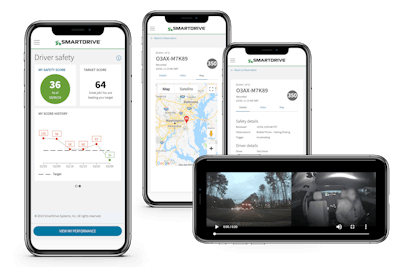 SmartDrive has a driver app and dash display for its video-based telematics system that fleets can use to provide feedback to drivers, automatically.
SmartDrive has a driver app and dash display for its video-based telematics system that fleets can use to provide feedback to drivers, automatically.Smart sensors can ascertain driver performance and deliver constructive feedback in real time through audio, video and text-to-speech to provide in-cab feedback for self-correction, he explains.
“Technology now provides iconography that tells drivers what issues to improve, measures performance improvement over time, and provides information as to how they’re performing to their peer group,” he says.
SmartDrive offers a video-based telematics and driver safety system that includes a driver app and dash display that fleets can use to provide prescriptive feedback to drivers, automatically, and “not blanket warnings with annoying beeps that drivers turn off or learn to ignore,” he says.
Scoring fatigue
Fatigue is an underlying factor in driver performance and safety behaviors. New developments can make fatigue scores part of the equation for driver monitoring and coaching.
Trimble Transportation has a Safety Analytics dashboard that it offers as an optional subscription to fleets using its mobility platform for electronic logs and other applications. Currently, the fleets who subscribe to Safety Analytics operate more than 100,000 drivers combined.
The dashboard identifies high-risk drivers based on safety behaviors for speeding, harsh braking, lane departures, hours-of-service violations and other areas. The dashboard integrates with third-party systems to bring in CSA data from Samba Safety and speed monitoring from SpeedGauge.
Trimble Transportation recently added a new option to monitor driver fatigue levels through an integration with Pulsar Informatics. The electronic logging data of fleets can automatically go to Pulsar’s data models for predicting fatigue based on driver’s work and rest activities over the last seven days.
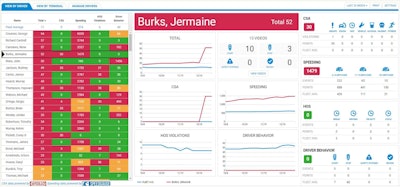 PeopleNet’s Safety Analytics dashboard segments drivers into green, yellow and red profiles of risk. A new feature adds predictive fatigue monitoring.
PeopleNet’s Safety Analytics dashboard segments drivers into green, yellow and red profiles of risk. A new feature adds predictive fatigue monitoring.A driver that changes from the day shift to the night shift is one example of what would elevate fatigue, explains Jim Angel, Trimble Transportation’s vice president of Video Intelligence.
Fatigue notifications appear in the Safety Analytics dashboard, and the text-to-speech feature of the in-cab device could be used to trigger an automatic message to drivers to contact the office, he says.
The risk scores in the Safety Analytics dashboard are elevated for drivers who have fatigue levels and exhibit other risky behaviors such as speeding or hard braking. The data may show a driver is spending less time on cruise during periods of fatigue to “keep themselves busy” or have higher fluctuations in speeds or an increase in sudden stops.
By making fatigue part of a driver scorecard system, “we are trying to make the data easy and effective and actionable,” he says.
If fleets want to use any or all of the data in Safety Analytics as part of a separate driver scorecard, the data is available for download from the Analytics dashboard, Angel says.



